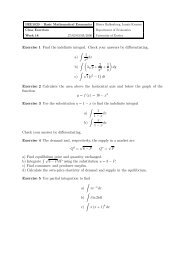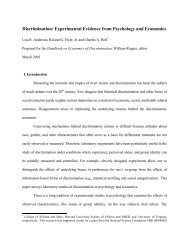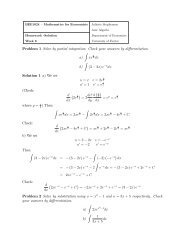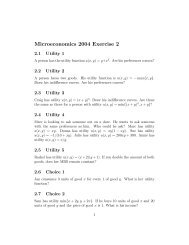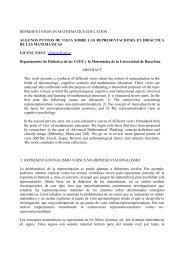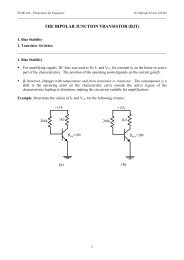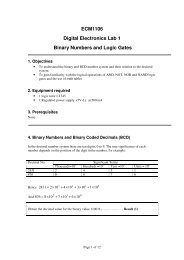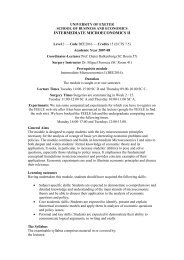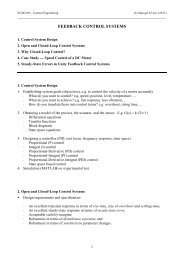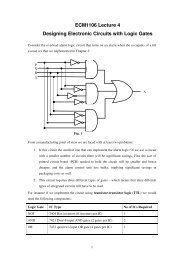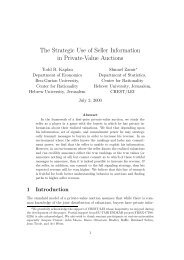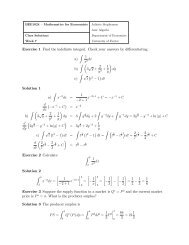Group Identity and Social Preferences
Group Identity and Social Preferences
Group Identity and Social Preferences
Create successful ePaper yourself
Turn your PDF publications into a flip-book with our unique Google optimized e-Paper software.
compared to outgroup matching, increases the likelihood of Player B’s positive reciprocation by19%. In addition, we find that B values A’s good intention measured by A’s payoff loss when Achooses to enter to help B. That is, the more A loses, the more likely B will reward. Specifically,a loss of 100 tokens in A’s payoff increases B’s likelihood to reward by about 30%. Furthermore,B’s self-benefit cost substantially reduces the probability of rewarding A. An interesting findingis the interaction between reciprocity <strong>and</strong> distribution preferences, i.e., B is less likely to returnA’s favor if doing so causes her to get a lower payoff than her match. In other words, an outcomewith more equal payoffs will increase the probability of positive reciprocation, which is consistentwith envy. All effects are statistically significant at the 5% level in both the control (column 1)<strong>and</strong> the treatment (column 2) conditions. In contrast, the potential benefit to Player A if Player Breciprocates has little effect on the likelihood of reciprocation.We now present a similar analysis for the negative reciprocity games. Specifically, we examinethe effects of five independent variables on the likelihood of B’s punishment, including the match’sgroup, B’s loss in payoff due to A’s entry, B’s cost of punishment, damage to A if B punishes, <strong>and</strong>B’s relative payoff in comparison to A’s. These variables are constructed in a similar way as theircounterparts in the analysis for positive reciprocity. 21 In all the Pareto-damaging games, B, bypunishing, gets a payoff that either equals or exceeds A’s. Hence, the design enables a comparisonbetween participant charity concern <strong>and</strong> negative reciprocity decisions.The logit results on negative reciprocity for the control <strong>and</strong> treatment sessions are presentedin columns (3) <strong>and</strong> (4) of Table 4. These results indicate that the ingroup matching significantlyreduces the likelihood of punishment by 12.8% (p < 0.01). This implies that Player B is morelenient towards misbehavior by an ingroup Player A. Compared to other independent variables,the cost variable has the largest effect. The results suggest that increasing B’s cost by 100 tokenswill lower the likelihood of punishment by 27.1% (p < 0.01) in the control <strong>and</strong> 31.7% (p < 0.01)in the treatment. We also find that the Damage to A variable has a positive sign. This coefficientindicates that the likelihood of B choosing to punish A is 4% (p < 0.05) higher if the punishmentimposes an additional 100 tokens of potential damage to A who has misbehaved. Again, participantdistribution preferences play a crucial role. Specifically, if B is in the lead, the likelihood of Bchoosing to punish A decreases by 17.0% (p < 0.05) in the control or 10.4% (p < 0.01) in thetreatment if the payoff difference rises by 100 tokens.Result 4 (Reciprocity). The participant reciprocity preference is significantly different betweeningroup <strong>and</strong> outgroup matches. Participants are more likely to reward an ingroup than an outgroupmatch for good behavior. They are significantly more forgiving towards misbehaviors from aningroup match compared to an outgroup match. The cost of reciprocating significantly lowers thelikelihood of reward or punishment.Support. In Table 4, the marginal effects of the ingroup match variable are 0.189 (p < 0.01) forspecification (2) <strong>and</strong> −0.128 (p < 0.01) for specification (4). For positive reciprocity, the marginaleffects of the cost variable are −0.705 <strong>and</strong> −0.341 for the control <strong>and</strong> treatment, respectively, bothof which are statistically significant at the 1% level. For negative reciprocity, the marginal effects21 Player B’s loss due to A’s entry is the difference in B’s payoff if A chooses Out <strong>and</strong> her expected payoff if Aenters. B’s cost to punish is her opportunity cost when choosing to punish A. The damage to A caused by B’s choiceto punish is computed as the loss of A’s payoff if B chooses to punish. In game Resp 13d, for example, B’s loss due toA’s entry is 575 tokens. B’s cost is 50 tokens, damage to A 800 tokens, <strong>and</strong> B will earn 150 tokens more than A if Bchooses to punish A. Again, the unit of these variables in the regressions is 100 tokens.15



